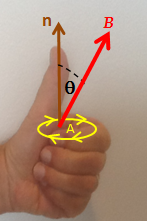There you go again with your besserwissen and dovngrading patronizings.
If you wich to learn some real cosmological physics connected to this OP, then read and study how something can cause different directions of rotation:
A Left Hand Rule for Faraday's Law. The sign of ΔΦ
B, the change in flux, is found based on the relationship between the magnetic field B, the area of the loop
A, and the normal n to that area, as represented by the fingers of the left hand. If ΔΦ
B is positive, the direction of the EMF is the same as that of the curved fingers (yellow arrowheads). If ΔΦ
B is negative, the direction of the EMF is against the arrowheads.
Shift the direction of the electric current and you´ll have different rotations - even on the galactic scale.
More here:
Faraday's law of induction (briefly,
Faraday's law) is a basic law of
electromagnetism predicting how a
magnetic field will interact with an
electric circuit to produce an
electromotive force (EMF)—a phenomenon known as
electromagnetic induction. It is the fundamental operating principle of
transformers,
inductors, and many types of
electrical motors,
generators and
solenoids.
[2][3]
The
Maxwell–Faraday equation (listed as one of
Maxwell's equations) describes the fact that a spatially varying (and also possibly time-varying, depending on how a magnetic field varies in time) electric field always accompanies a time-varying magnetic field, while Faraday's law states that there is EMF (electromotive force, defined as electromagnetic work done on a unit charge when it has traveled one round of a conductive loop) on the conductive loop when the magnetic flux through the surface enclosed by the loop varies in time.
Faraday's law had been discovered and one aspect of it (transformer EMF) was formulated as the Maxwell–Faraday equation later. The equation of Faraday's law can be derived by the Maxwell–Faraday equation (describing transformer EMF) and the
Lorentz force (describing motional EMF). The integral form of the Maxwell–Faraday equation describes only the transformer EMF, while the equation of Faraday's law describes both the transformer EMF and the motional EMF.
Contents

